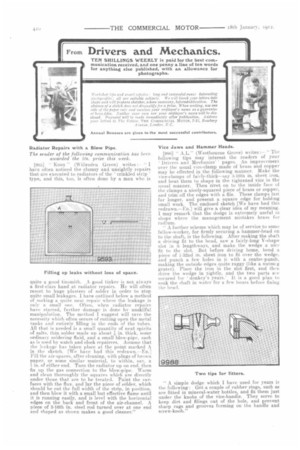Drivers and Mechanics.
Page 20

If you've noticed an error in this article please click here to report it so we can fix it.
com
munication received, and one penny a line of ten words TEN SHILLINGS WEEKLY is paid for the best for anything else published, with an allowance for
iVorks74 Iiihs and smart rePairs ; long and successful runs ; interesting photographs all are suitable subjects. We will knock your letters into shape and will firePare sketches, where necessary, beforel)ublication. The absence of a sketch, does not disqualify for a Prise. When writing, use one side of the paper only and mention your employer's name as a guarantee or bona fides. Xeither your own nor your emPloyer's name will be disclosed. Payment will he made immediately after publication. Address your letters to The Editor, THE COMMERCIAL MOTOR, 7-15, Rosebery
Avenue, London, E.G.
Annual Bonuses are given to the most successful contributors.
Radiator Repairs with a Blow Pipe.
The sender of the following communication has been. awarded the 108. prize this week, [985] " Kosn " (Willesden Green) writes : " I have often noticed the clumsy and unsightly repairs that are executed to radiators of the crinkled strip ' type, and this, too, is often done by a, man who is quite a good tinsmith. A good tinker is not always a first-class hand at radiator repairs. He will often resort to huge plasters of solder in order to stop quite small leakages. I have outlined below a method of making a quite neat repair where the leakage is only a small one. Often, when radiator repairs have started, further damage is done by unskilful manipulation. The method I suggest will save the necessity which often occurs of cutting open the metal tanks and entirely filling in the ends of the tubes. All that is needed is a small quantity of neat spirits of salts, thin solder made up about 1, in. thick, some ordinary soldering fluid, and a small blow-pipe, such as is used by watch and clock repairers. Assume that the leakage has taken place at the point marked A in the sketch. rwe have had this redrawn.—En.] Fill the air-spaces, after cleaning. with plugs of brown paper, or some similar material, to within, say, a -} in. of either end. Turn the radiator up on end. then fix up the gas connection to the blow-pipe. Warm and clean thoroughly the squares which are directly under those that are to be treated. Paint the surfaces with the flux, and lay the piece of solder, which should be cut the full width of the strip, in position, and then blow it with a small but effective flame until it is running easily, and is level with the horizontal edges on the back and front of the air-channel. A piece of 3-16th in. steel rod turned over at one end and shaped as shown makes a. good cleaner."
Vice Jaws and Hammer Heads.
[980 " A.L." (Westbourne Grove) writes :— " The following tips may interest the readers of your ' Drivers and Mechanics" pages. An improvement over the usual vice-clamp made of brass and copper may be effected in the following manner. Make the vice-clamps of fairly-thick—say 3-16th in. sheet iron, and beat them to shape in the tightened vice in the usual manner. Then rivet on to the inside face of the clamps a nicely-squared piece of brass or copper, and trim off the edges with a file. These clamps last far longer, and present a square edge for holding small work. The enclosed sketch [We have had this redrawn.—En.] will give a clear idea of my meaning. I may remark that the dodge is extremely useful in shops where the management mistakes brass for radium.
" A further scheme which may be of service to some fellow-worker, for firmly securing a hammer-head on to the shaft, is the following. After making the shaft a driving fit to the head, saw a fairly-long V-shape slot in it lengthways, and make the wedge a nice fit to the slot. But before driving home, bend a piece of 1-32nd in. sheet iron to fit over the wedge, and punch a few holes in it with a centre-punch, making the outside edges quite. raggy (like a nutmeg grater). Place the iron in the slot first, and then drive the wedge in tightly, and the two parts are secured for donkey's years.' It is a good plan to soak the shaft in water for a few hours before fixing the hoa:1 " A simple dodge which I have used for years is the following: Get a couple of rubber rings, such as are fitted in mineral-water bottles, and fit them just under the knobs of the vice-handle. They serve to keep dirt and filings out of the hole, and prevent sharp rags and grooves forming on the handle and screw-knob."






















